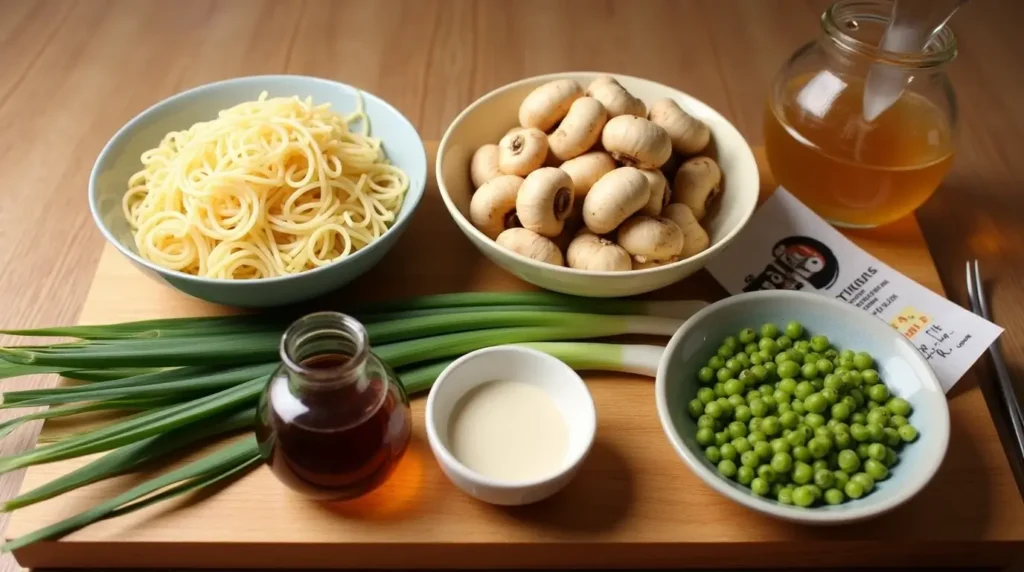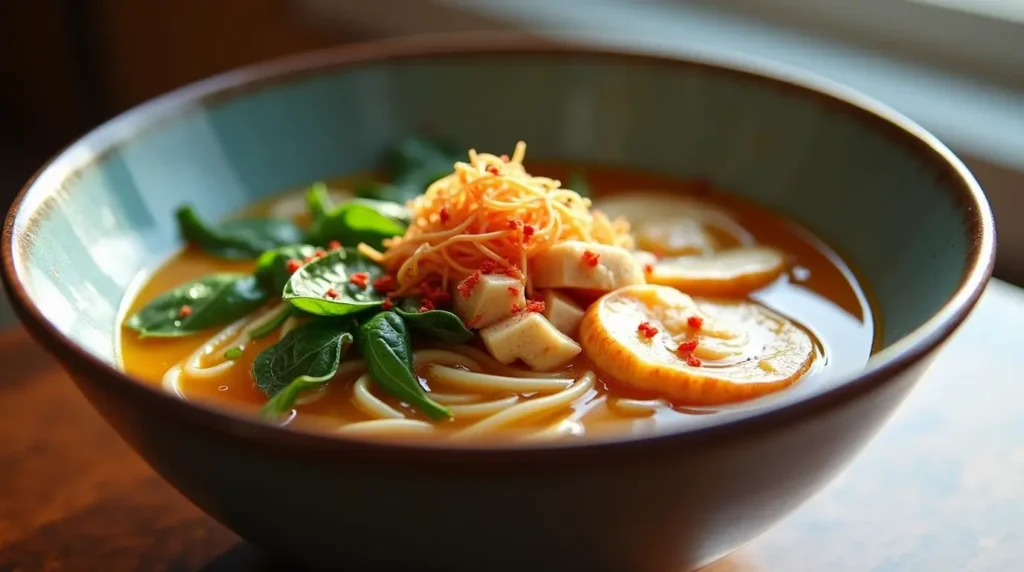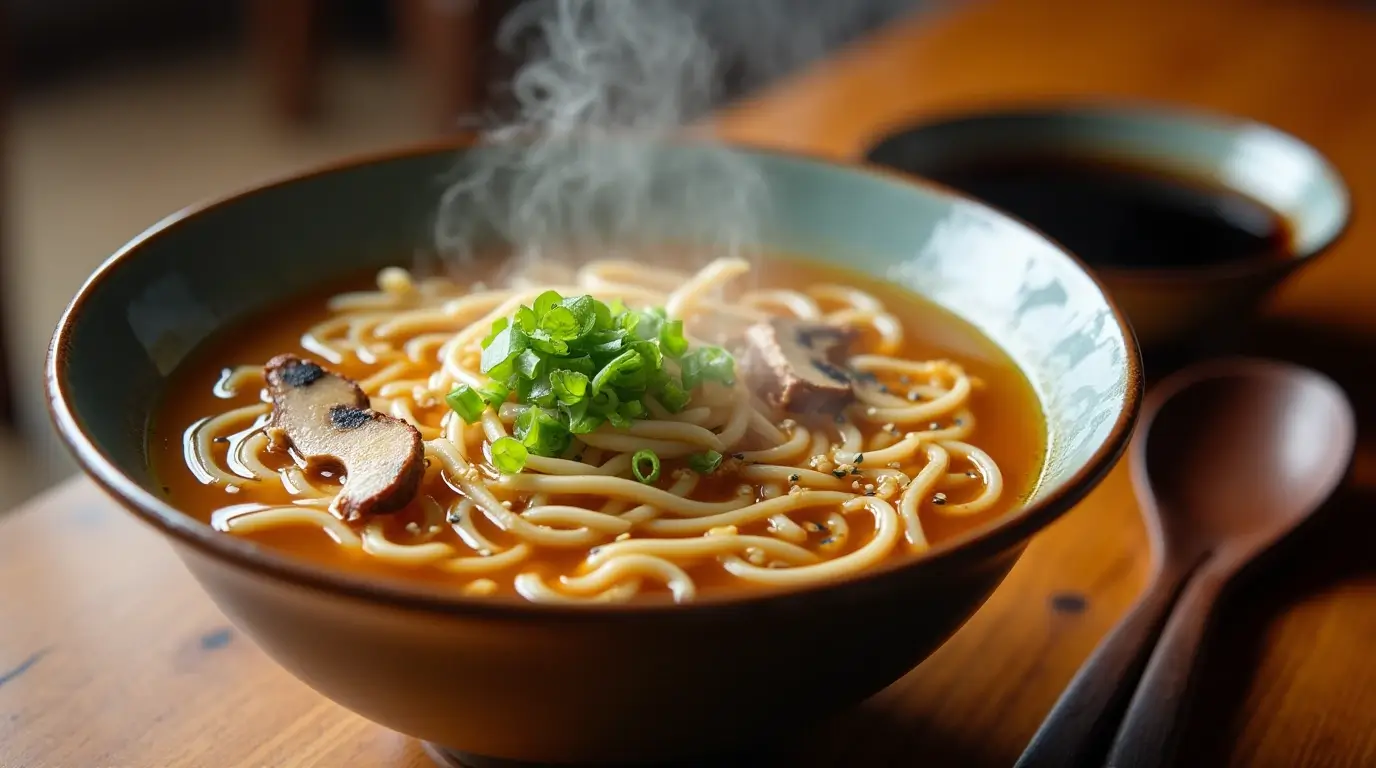Udon soup is a cornerstone of Japanese cuisine, celebrated for its versatility and heartwarming flavors. When paired with enoki mushrooms, this dish transforms into a comforting bowl that combines delicate textures and rich tastes. In this article, we’ll dive deep into everything you need to know about Japanese udon soup with enoki, from its origins and ingredients to its health benefits and recipe variations. Whether you’re a seasoned cook or a curious food lover, this guide promises to inspire your culinary journey.
Table of contents
Introduction to Japanese Udon Soup with Enoki
What is Udon Soup?
Udon soup is a classic Japanese dish featuring thick, chewy noodles served in a flavorful broth. The base is often made with dashi, a traditional Japanese stock, combined with soy sauce or miso for depth. This dish is loved for its simplicity and adaptability, offering endless options for toppings and accompaniments.
The noodles, made from wheat flour, are the star of the dish, providing a satisfying texture that complements the broth. In Japan, udon is enjoyed year-round, served hot in winter and chilled during the summer months.
Overview of Enoki Mushrooms
Enoki mushrooms are a staple in Japanese cooking, prized for their slender stems, delicate caps, and mild, slightly nutty flavor. They pair beautifully with the robust umami of udon soup, adding a subtle crunch and visual appeal to the dish. Rich in nutrients and low in calories, enoki mushrooms are a healthful addition to any meal.
Why Combine Udon and Enoki?
The combination of udon noodles and enoki mushrooms found in this Japanese Udon Soup with Enoki creates a dish that is both comforting and elegant. The soft chewiness of the noodles contrasts with the crisp texture of the mushrooms, while their flavors meld seamlessly in the broth. This pairing not only pleases the palate but also provides a balanced meal packed with nutrients.
In the sections that follow, we’ll explore how to create this delightful dish at home, its variations, and why it’s a must-try for anyone looking to experience authentic Japanese flavors.
Ingredients and Preparation
Essential Ingredients for Authentic Udon Soup
The magic of Japanese udon soup with enoki lies in its thoughtfully selected ingredients. For an authentic flavor, you’ll need the following essentials:
- Udon Noodles: Opt for fresh noodles if possible. They boast a chewy texture and a subtle wheat flavor. Dried udon works too, but ensure you cook it to the right consistency.
- Enoki Mushrooms: Look for fresh, firm stems with creamy white caps. These mushrooms add a mild crunch that balances the softness of the noodles.
- Broth Base: Dashi, a Japanese stock made from kombu (seaweed) and katsuobushi (bonito flakes), is the backbone of the soup. Enhance it with soy sauce or miso for depth.
Other Complementary Ingredients
While the essentials make up the heart of the dish, additional ingredients can elevate its taste and texture:
- Proteins: Marinated chicken, tofu, or seafood like shrimp or fish cakes.
- Vegetables: Spinach, bok choy, or thinly sliced carrots.
- Aromatic Add-ons: Scallions, garlic, or a hint of ginger for an extra kick.
Common Add-Ons
Udon soup thrives on its flexibility. Garnish with seaweed (nori), sesame seeds, or even a soft-boiled egg. These toppings not only enhance flavor but also bring visual appeal to your bowl of Japanese Udon Soup with Enoki.
Discover more soup variations on KCAL Recipes, such as their Mexican Chicken Soup .
Step-by-Step Recipe

Preparing the Broth
Start with the broth, the soul of Japanese udon soup with enoki.
- Make Dashi Stock: Simmer kombu and katsuobushi in water. Strain to create a clear, umami-packed base.
- Enhance Flavors: Add soy sauce for a salty tang or miso for a creamy finish. Adjust to taste.
Cooking Udon Noodles
While the broth simmers, prepare the noodles:
- Boil in Salted Water: Fresh udon cooks in about 3–5 minutes. Dried noodles may take longer.
- Drain and Rinse: Rinse under cold water to stop cooking and remove excess starch.
Adding Toppings
This step transforms the soup into a meal.
- Enoki Mushrooms: Trim the roots, rinse lightly, and add directly to the hot broth. They cook quickly, retaining their crunch.
- Protein and Vegetables: Sauté or steam chicken, tofu, or vegetables before adding them to the soup.
Assembly and Serving Tips
- Combine the Components: Pour hot broth over cooked noodles in a deep bowl.
- Layer Garnishes: Arrange enoki, scallions, or nori on top for a visually appealing presentation.
- Serve Immediately: Udon soup is best enjoyed fresh, piping hot.
For more soup assembly tips, check out KCAL Recipes Cream of Chicken Soup Guide .
PrintJapanese Udon Soup with Enoki: A Culinary Guide
- Total Time: 40 min
- Yield: 2 servings 1x
Description
Enjoy this heartwarming bowl of udon soup that’s both delicious and nourishing. Whether you’re looking for a quick meal or a cozy dinner, this Japanese udon soup with enoki mushrooms is sure to impress your taste buds. Let’s dive into the details!
Ingredients
For the Broth:
- 4 cups dashi stock (or substitute with vegetable broth for a vegetarian option)
- 2 tablespoons soy sauce
- 1 tablespoon mirin
- 1 tablespoon sake (optional, for depth of flavor)
- 1 teaspoon sugar
For the Udon Soup:
- 2 servings of fresh or frozen udon noodles
- 1 bunch of enoki mushrooms, trimmed and cleaned
- 1 cup bok choy, roughly chopped
- 1 medium carrot, julienned or thinly sliced
- 2 soft-boiled eggs (optional but recommended)
- 2 green onions, thinly sliced
- 1 sheet of nori, cut into strips (optional, for garnish)
- 1 teaspoon sesame oil (for garnish)
- Toasted sesame seeds (optional, for garnish)
Instructions
Prepare the Broth:
- In a medium-sized pot, combine the dashi stock, soy sauce, mirin, sake, and sugar. Bring to a gentle simmer over medium heat and let it cook for 5 minutes to allow the flavors to meld. Adjust seasoning to taste.
Prepare the Noodles:
- Cook the udon noodles according to package instructions. If using fresh or frozen noodles, boil for 2-3 minutes or until tender. Drain and set aside.
Cook the Vegetables and Mushrooms:
- Add the carrots and bok choy to the simmering broth and cook for 3-4 minutes, until tender but still vibrant.
- Add the enoki mushrooms during the last minute of cooking, as they cook very quickly.
Assemble the Soup:
- Divide the cooked udon noodles between two bowls. Ladle the hot broth and vegetables over the noodles.
- Top each bowl with a soft-boiled egg (sliced in half), green onions, and strips of nori if using.
Garnish and Serve:
- Drizzle a little sesame oil over the soup and sprinkle with toasted sesame seeds for added flavor. Serve immediately while hot.
Notes
- Dashi Stock: If you’re short on time, instant dashi granules can be used. For a vegetarian option, use kombu (seaweed) and shiitake mushrooms to create a flavorful dashi base.
- Udon Noodles: Fresh or frozen udon noodles are preferable for their chewy texture, but dried udon can also be used.
- Customization: Add tofu, shrimp, or chicken for extra protein, or switch up the vegetables based on your preference.
- Soft-Boiled Eggs: To make perfect soft-boiled eggs, cook them in boiling water for 6-7 minutes, then transfer them to an ice bath before peeling.
- Prep Time: 15 min
- Cook Time: 25 min
Nutrition
- Calories: 350
- Sugar: 6g
- Sodium: 1100mg
- Fat: 10g
- Saturated Fat: 2g
- Unsaturated Fat: 7g
- Trans Fat: 0
- Carbohydrates: 50g
- Fiber: 4g
- Protein: 12g
- Cholesterol: 90mg
Health Benefits of Japanese Udon Soup with Enoki
Nutritional Value of Udon Noodles
Udon noodles are more than just delicious—they’re a great source of energy, thanks to their carbohydrate content. Made from wheat flour, these noodles are low in fat, making them a comforting yet light addition to your meals. Paired with a flavorful broth, they become a wholesome base for Japanese udon soup with enoki.
Health Benefits of Enoki Mushrooms
Enoki mushrooms are a powerhouse of nutrients. Low in calories and high in antioxidants, they support immune health and improve digestion. These mushrooms also contain essential vitamins like B-complex and minerals such as potassium, which contribute to overall wellness. Their fiber content aids digestion, making them a healthy choice for any soup.
A Low-Calorie and Balanced Meal
This combination of noodles and mushrooms creates a satisfying yet light dish. The addition of vegetables, proteins, and a dashi-based broth rounds out the meal, offering a balanced mix of macronutrients. Whether you’re watching your calorie intake or looking for a nourishing comfort food, this dish fits the bill perfectly.
For tips on creating low-calorie meals, explore KCAL Recipes Healthy Chicken Cabbage Dishes.
Variations of Udon Soup with Enoki

Regional Udon Soup Styles in Japan
Japan boasts a variety of udon soup styles, each with its unique twist:
- Kansai-Style Udon: Known for its light, clear broth, this version uses a delicate dashi that allows the flavor of enoki mushrooms to shine.
- Kanto-Style Udon: Features a darker, richer broth made with soy sauce. The deep flavor complements the mildness of enoki.
- Nabeyaki Udon: A hearty, one-pot meal often served in winter, topped with tempura and an egg.
Fusion Recipes with Udon and Enoki
For a modern twist, blend Japanese udon soup with enoki into global cuisines:
- Miso-Enoki Ramen: Combine ramen spices with udon noodles and mushrooms.
- Spicy Korean-Style Udon: Add gochujang (Korean chili paste) for a fiery kick.
- Creamy Udon Soup: Use a coconut milk base infused with dashi for a fusion of Japanese and Thai flavors.
Customizing Soup for Dietary Needs
No matter your dietary preference, Japanese Udon Soup with Enoki can be adapted to suit you:
- Vegan Option: Replace dashi with kombu (seaweed) and shiitake mushroom stock. Add tofu and vegetables for protein.
- Gluten-Free Version: Swap wheat-based udon for rice noodles and adjust the broth with tamari instead of soy sauce.
Frequently Asked Questions
What is the Best Way to Store Enoki Mushrooms?
To keep enoki mushrooms fresh, store them in their original packaging or wrap them in a paper towel and place them in a loosely sealed plastic bag. Keep them in the vegetable drawer of your refrigerator. Avoid washing them until you’re ready to use them, as excess moisture can cause them to spoil quickly.
Can I Freeze Udon Soup?
While freezing udon noodles separately works well, freezing the entire soup can alter its texture, especially for ingredients like enoki mushrooms. To enjoy the best flavor and texture, freeze the broth and noodles separately, and add fresh toppings when reheating.
What Are the Most Popular Toppings for Udon?
Beyond enoki mushrooms, popular toppings include tempura shrimp, soft-boiled eggs, nori (seaweed), and scallions. These ingredients enhance the flavor and presentation of Japanese udon soup with enoki.
Is Udon Soup Suitable for a Gluten-Free Diet?
Traditional udon noodles contain wheat, so they’re not gluten-free. However, you can substitute them with rice or buckwheat noodles and adjust the broth using tamari instead of regular soy sauce to make it gluten-free.
Nutritional Content of Japanese Udon Soup with Enoki
Why Nutrition Matters
Japanese udon soup with enoki is not only delicious but also offers a nutritious meal option. Understanding its nutritional breakdown can help you incorporate it into a balanced diet. Below is an estimated nutritional content per 100g serving of the soup, including the broth, noodles, and enoki mushrooms.
Nutritional Content (Per 100g)
| Nutrient | Amount | Percentage of Daily Value (%DV) |
|---|---|---|
| Calories | 50 kcal | 2% |
| Protein | 2 g | 4% |
| Carbohydrates | 8 g | 3% |
| Fat | 0.5 g | 1% |
| Dietary Fiber | 1 g | 4% |
| Sodium | 350 mg | 15% |
| Potassium | 150 mg | 4% |
| Vitamin B2 (Riboflavin) | 0.1 mg | 6% |
| Iron | 0.5 mg | 3% |
Notes on Nutritional Content
- The calorie count may vary depending on the type and quantity of broth, noodles, and toppings used.
- Enoki mushrooms contribute significantly to the fiber and potassium content, while udon noodles are the primary source of carbohydrates.
- For a healthier version, use low-sodium soy sauce or miso paste to reduce the sodium content.
This table provides a general idea, but customizing ingredients can adjust the nutritional profile to your preferences. Let me know if you’d like any further refinements or if you’d like to discuss dietary adjustments!
Tips for Perfecting Japanese Udon Soup with Enoki
Balancing Flavors in the Broth
The broth is the soul of Japanese udon soup with enoki. To perfect it, focus on balancing flavors.
- Use a combination of dashi, soy sauce, and mirin for a classic umami profile. If you prefer a slightly sweeter note, add a pinch of sugar or a drizzle of honey.
- For a richer depth, experiment with miso paste or add a small splash of sake.
Always taste as you go, adjusting the saltiness or sweetness to suit your palate. A well-balanced broth enhances the flavors of the enoki mushrooms and udon noodles.
Getting the Right Noodle Texture
Achieving the ideal texture for udon noodles is crucial. Cook them just until they’re al dente—soft yet chewy. Overcooking can make them mushy, which might detract from the overall dish. Rinse the noodles in cold water after cooking to stop them from overcooking and remove excess starch.
Enhancing Presentation
Presentation matters when serving Japanese udon soup with enoki. Arrange toppings neatly to create a visually appealing dish. Place the enoki mushrooms in a small bundle, add a sprig of fresh herbs like cilantro or parsley, and sprinkle sesame seeds or chili flakes for a pop of color.
Bringing Udon Soup Into Your Culinary Routine
Pairing Udon Soup with Other Dishes
Japanese udon soup with enoki can be a meal on its own or part of a larger spread. Pair it with:
- Gyoza (dumplings): Their crispy, savory filling complements the soup’s delicate flavors.
- Japanese Pickles: Add a crunchy, tangy side to balance the soup’s richness.
- Tempura Vegetables: Lightly battered and fried, they add texture and variety.
Creating a Weekly Tradition
Bring the comfort of udon soup into your weekly routine. Reserve one evening a week for a “Japanese soup night.” Experiment with variations by swapping out proteins, vegetables, or garnishes. This way, you can explore the versatility of udon without getting bored.
A Dish for Every Occasion
Whether it’s a cozy night in or a meal to impress guests, udon soup fits the bill. Its simplicity allows for quick preparation, while its flavors and presentation can be elevated for special occasions.
[For more inspiration, explore KCAL Recipes’ hearty meal ideas to complement your soup nights.]
Conclusion and Final Thoughts
Japanese udon soup with enoki is more than just a meal—it’s a sensory experience. The chewy noodles, delicate crunch of enoki mushrooms, and the rich, umami-packed broth come together to create a dish that is both comforting and nourishing.
Whether you’re exploring traditional Japanese flavors or experimenting with global twists, this soup offers endless possibilities. With its nutritional benefits and versatility, it’s a perfect addition to any mealtime repertoire.
If you’re new to cooking Japanese dishes, start simple: prepare the dashi, add udon noodles, and top with enoki mushrooms. As you grow more confident, explore the regional styles and fusion options outlined in this guide.
For more delicious soup recipes, explore KCAL Recipes’ tips on creating balanced, flavorful meals.

